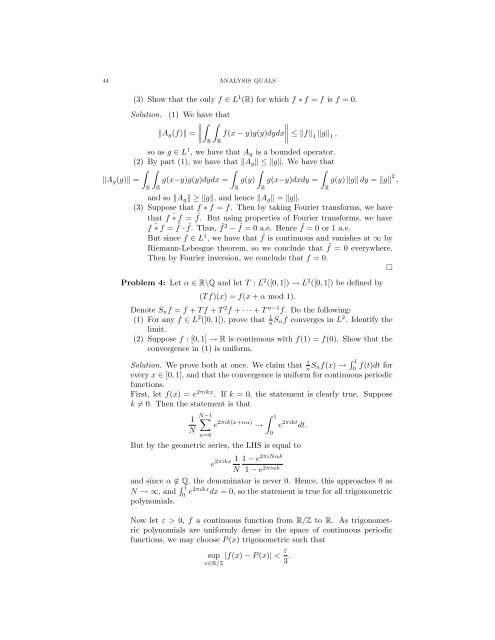ANALYSIS QUALIFYING EXAM PROBLEMS BRIAN LEARY ...
ANALYSIS QUALIFYING EXAM PROBLEMS BRIAN LEARY ...
ANALYSIS QUALIFYING EXAM PROBLEMS BRIAN LEARY ...
You also want an ePaper? Increase the reach of your titles
YUMPU automatically turns print PDFs into web optimized ePapers that Google loves.
44 <strong>ANALYSIS</strong> QUALS<br />
(3) Show that the only f ∈ L 1 (R) for which f ∗ f = f is f = 0.<br />
Solution. (1) We have that<br />
<br />
<br />
<br />
<br />
<br />
Ag(f) = <br />
f(x − y)g(y)dydx<br />
≤ f1 g1 ,<br />
R<br />
R<br />
so as g ∈ L1 , we have that Ag is a bounded operator.<br />
(2) By part (1), we have that Ag ≤ g. We have that<br />
<br />
<br />
<br />
Ag(g) = g(x−y)g(y)dydx = g(y) g(x−y)dxdy = g(y) g dy = g 2 ,<br />
R<br />
R<br />
R<br />
R<br />
and so Ag ≥ g, and hence Ag = g.<br />
(3) Suppose that f ∗ f = f. Then by taking Fourier transforms, we have<br />
that f ˆ∗<br />
f = ˆ f. But using properties of Fourier transforms, we have<br />
f ˆ∗<br />
f = ˆ f · ˆ f. Thus, ˆ f 2 − ˆ f = 0 a.e. Hence ˆ f = 0 or 1 a.e.<br />
But since f ∈ L1 , we have that ˆ f is continuous and vanishes at ∞ by<br />
Riemann-Lebesgue theorem, so we conclude that ˆ f = 0 everywhere.<br />
Then by Fourier inversion, we conclude that f = 0.<br />
<br />
Problem 4: Let α ∈ R\Q and let T : L 2 ([0, 1]) → L 2 ([0, 1]) be defined by<br />
(T f)(x) = f(x + α mod 1).<br />
Denote Snf = f + T f + T 2f + · · · + T n−1f. Do the following:<br />
(1) For any f ∈ L2 ([0, 1]), prove that 1<br />
nSnf converges in L2 . Identify the<br />
limit.<br />
(2) Suppose f : [0, 1] → R is continuous with f(1) = f(0). Show that the<br />
convergence in (1) is uniform.<br />
Solution. We prove both at once. We claim that 1<br />
nSnf(x) → 1<br />
f(t)dt for<br />
0<br />
every x ∈ [0, 1], and that the convergence is uniform for continuous periodic<br />
functions.<br />
First, let f(x) = e2πikx . If k = 0, the statement is clearly true. Suppose<br />
k = 0. Then the statement is that<br />
N−1<br />
1 <br />
e<br />
N<br />
2πik(x+nα) →<br />
n=0<br />
1<br />
0<br />
e 2πikt dt.<br />
But by the geometric series, the LHS is equal to<br />
2πikx 1 1 − e<br />
e<br />
N<br />
2πiNαk<br />
1 − e2πiαk and since α /∈ Q, the denominator is never 0. Hence, this approaches 0 as<br />
N → ∞, and 1<br />
0 e2πikxdx = 0, so the statement is true for all trigonometric<br />
polynomials.<br />
Now let ε > 0, f a continuous function from R/Z to R. As trigonometric<br />
polynomials are uniformly dense in the space of continuous periodic<br />
functions, we may choose P (x) trigonometric such that<br />
sup |f(x) − P (x)| <<br />
x∈R/Z<br />
ε<br />
3 .<br />
R
















